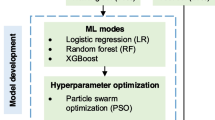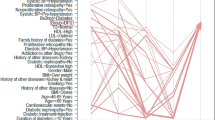Abstract
Early identification of the risk factors associated with development of diabetic foot ulcer (DFU) can be facilitated using machine learning techniques. The aim of this study is to find out the association of various clinical and biochemical risk factors with DFU and develop a prediction model using different machine learning algorithms. Eighty each of type 2 diabetes mellitus (T2DM) with DFU and (T2DM) without DFU were enrolled for this observational study. Clinical and laboratory data were analysed using different machine learning algorithms: Support vector machines (SVM-Poly K), Naive Bayes (NB), K-nearest neighbour (KNN), random forest (RF) and three ensemble learners: Stacking C, Bagging and AdaBoost for constructing prediction models for discriminating between the two groups (stage I classification) and ulcer type classification (stage II classification). Ensemble learning performed better than individual classifiers in terms of various performance evaluation metrics. New risk factors like ApoA1 and IL-10 for development of DFU in diabetes mellitus were identified. IL-10 along with uric acid could discriminate the grades of ulcers according to its severity. Decision fusion strategy using Stacking C algorithm resulted in enhanced prediction accuracy for both the stages of classification which can be used as a complementary method for computational screening for DFU and its subtypes.
Graphical abstract
Current methodology for T2DM with DFU/T2DM without DFU and ulcer type classification


Similar content being viewed by others
References
Vibha SP, Kulkarni MM, Kirthinath Ballala AB, Kamath A, Maiya GA (2018) Community based study to assess the prevalence of diabetic foot syndrome and associated risk factors among people with diabetes mellitus. BMC Endocr Disord 18(1):1–9
Armstrong DG, Swerdlow MA, Armstrong AA, Conte MS, Padula WV, Bus SA (2020) Five year mortality and direct costs of care for people with diabetic foot complications are comparable to cancer. J Foot Ankle Res13(1):16. https://doi.org/10.1186/s13047-020-00383-2
Aan de Stegge WB, Abu-Hanna A, Bus SA (2020) Development of a multivariable prediction model for plantar foot ulcer recurrence in high-risk people with diabetes. BMJ Open Diabetes Res Care 8(1):e001207
Goyal M, Reeves ND, Davison AK, Rajbhandari S, Spragg J, Yap MH (2020) DFUNet: convolutional neural networks for diabetic foot ulcer classification. IEEE Trans Emerg Top Comput Intell 4(5):728–739
Alzubaidi L, Fadhel MA, Oleiwi SR, Al-Shamma O, Zhang J (2020) DFU_QUTNet: diabetic foot ulcer classification using novel deep convolutional neural network. Multimed Tools Appl [Internet]. 79(21):15655–77. https://doi.org/10.1007/s11042-019-07820-w
Tulloch J, Zamani R, Akrami M (2020) Machine learning in the prevention, diagnosis and management of diabetic foot ulcers: a systematic review. IEEE Access 8:198977–199000
Tesfaye S, Boulton AJM, Dyck PJ, Freeman R, Horowitz M, Kempler P et al (2010) Diabetic neuropathies: update on definitions, diagnostic criteria, estimation of severity, and treatments. Diabetes Care 33(10):2285–2293
Frykberg RG (2002) Diabetic foot ulcers: pathogenesis and management. Am Fam Physician 66(9):1655–1662
Breiman L (2001) Random Forests. Mach Learn [Internet]. 45(1):5–32. https://doi.org/10.1023/A:1010933404324
Nath A, Subbiah K (2015) Maximizing lipocalin prediction through balanced and diversified training set and decision fusion. Comput Biol Chem [Internet]. 59:101–10. Available from: http://www.sciencedirect.com/science/article/pii/S1476927115301821
Breiman L (1996) Bagging Predictors. Mach Learn [Internet]. 24(2):123–40. https://doi.org/10.1023/A:1018054314350
Hearst MA (1998) 1998 Support vector machines. IEEE Intell Syst [Internet]. 13(4):18–28. https://doi.org/10.1109/5254.708428
Keerthi SS, Shevade SK, Bhattacharyya C, Murthy KRK (2001) Improvements to Platt’s SMO algorithm for SVM classifier design. Neural Comput 13(3):637–649
Nath A, Subbiah K (2016) Insights into the molecular basis of piezophilic adaptation: extraction of piezophilic signatures. J Theor Biol 7:390:117–126. https://doi.org/10.1016/j.jtbi.2015.11.021
Kramer O (2013) K-Nearest Neighbors. In: Dimensionality reduction with unsupervised nearest neighbors Intelligent Systems Reference Library, Vol 51. Springer Berlin Heidelberg. https://doi.org/10.1007/978-3-642-38652-7_2
Webb GI (2011) Naïve Bayes. In: Sammut C, Webb GI (eds) Encyclopedia of machine learning. Springer, Boston, MA. https://doi.org/10.1007/978-0-387-30164-8_576
Polikar R (2006) Ensemble based systems in decision making. IEEE Circuits Syst Mag 6(3):21–45
Seewald AK (2002) How to make stacking better and faster while also taking care of an unknown weakness. Proceedings of the Nineteenth International Conference on Machine Learning. Morgan Kaufmann Publishers Inc., p 554–561
Freund Y, Schapire RE (1996) Experiments with a new boosting algorithm. Proceedings of the Thirteenth International Conference on International Conference on Machine Learning. Morgan Kaufmann Publishers Inc., Bari, Italy, p 148–156
Wei Q, Dunbrack Jr RL (2013) The role of balanced training and testing data sets for binary classifiers in bioinformatics. PLoS One 8(7):e67863–e67863. https://pubmed.ncbi.nlm.nih.gov/23874456
Nath A, Subbiah K (2018) The role of pertinently diversified and balanced training as well as testing data sets in achieving the true performance of classifiers in predicting the antifreeze proteins. Neurocomputing 272:294–305. http://www.sciencedirect.com/science/article/pii/S0925231217312341
Chawla NV, Bowyer KW, Hall LO, Kegelmeyer WP (2002) SMOTE: synthetic minority over-sampling technique. J Artif Int Res 16(1):321–357
Sánchez-Maroño N, Alonso-Betanzos A, Tombilla-Sanromán M (2007) Filter methods for feature selection: a comparative study. Proceedings of the 8th international conference on Intelligent data engineering and automated learning. Springer-Verlag, Birmingham, UK, p 178–187
Nath A (2016) Insights into the sequence parameters for halophilic adaptation. Amino Acids [Internet]. 48(3):751–62. Available from: https://doi.org/10.1007/s00726-015-2123-x
Urbanowicz RJ, Meeker M, La Cava W, Olson RS, Moore JH (2018) Relief-based feature selection: Introduction and review. J Biomed Inform [Internet]. 85:189–203. Available from: https://www.sciencedirect.com/science/article/pii/S1532046418301400
Roobaert D, Karakoulas G, Chawla NV (2006) Information gain, correlation and support vector machines. In: Guyon I, Nikravesh M, Gunn S, Zadeh LA (eds) Feature extraction. Studies in fuzziness and soft computing, vol 207. Springer, Berlin, Heidelberg. https://doi.org/10.1007/978-3-540-35488-8_23
Karegowda A, Manjunath A, Jayram MA (2010) Comparative study of attribute selection using gain ratio and correlation based feature selection. Int J Inf Technol Knowl Manag 2(2):271–277
Liu H, Setiono R (1995) Chi2: feature selection and discretization of numeric attributes. In: Anon (ed) Proceedings of the International Conference on Tools with Artificial Intelligence. IEEE, pp 388–391
Hall M, Frank E, Holmes G, Pfahringer B, Reutemann P, Witten IH (2009) The WEKA data mining software: an update. SIGKDD Explor Newsl [Internet]. 11(1):10–18. https://doi.org/10.1145/1656274.1656278
Chicco D, Jurman G (2020) The advantages of the Matthews correlation coefficient (MCC) over F1 score and accuracy in binary classification evaluation. BMC Genomics [Internet]. 21(1):6. https://doi.org/10.1186/s12864-019-6413-7
Zhang E, Zhang Y.F-Measure. In: Liu L, ÖZsu MT (eds) Encyclopedia of database systems. Springer, NewYork, NY. https://doi.org/10.1007/978-1-4614-8265-9_483
Bradley AP (1997) The use of the area under the ROC curve in the evaluation of machine learning algorithms. Pattern Recogn [Internet]. 30(7):1145–1159. https://doi.org/10.1016/S0031-3203(96)00142-2
Wolpert DH (1996) The lack of a priori distinctions between learning algorithms. Neural Comput 8(7):1341–1390
Steen EH, Wang X, Balaji S, Butte MJ, Bollyky PL, Keswani SG (2020) The role of the anti-inflammatory cytokine interleukin-10 in tissue fibrosis. Adv Wound Care (New Rochelle) 9(4):184–198. https://doi.org/10.1089/wound.2019.1032
DeClue CE, Shornick LP (2015) The cytokine milieu of diabetic wounds. Diabetes Manag 5(6):525–535
Barry JC, Shakibakho S, Durrer C, Simtchouk S, Jawanda KK, Cheung ST et al (2016) Hyporesponsiveness to the anti-inflammatory action of interleukin-10 in type 2 diabetes. Sci Rep 17(6):21244. https://doi.org/10.1038/srep21244
Mangaraj M, Nanda R, Panda S (2016) Apolipoprotein A-I: a molecule of diverse function. Indian J Clin Biochem 31(3):253–259. https://doi.org/10.1007/s12291-015-0513-1
Tiniakou I, Drakos E, Sinatkas V, Van Eck M, Zannis VI, Boumpas D et al (2015) High-density lipoprotein attenuates Th1 and th17 autoimmune responses by modulating dendritic cell maturation and function. J Immunol 194(10):4676–4687. https://doi.org/10.4049/jimmunol.1402870
Bruhn-Olszewska B, Koron-Burakowska A, Gabig-Ciminska M, Olszweski P, Wegrzyn A, Jakobkiewicz-Banecka J (2012) Molecular factors involved in the development of diabetic foot syndrome. Acta Biochimica Plonica 59(4):507–513
Xiong Xf, Wei L, Xiao Y, An YC, Yang J, Zhao H et al (2020) Family history of diabetes is associated with diabetic foot complications in type 2 diabetes. Sci Rep 10:17056. https://doi.org/10.1038/s41598-020-74071-3
Palatini P (2018) Risk of developing foot ulcers in diabetes. J of Hypertens 36(11):2132–2134. https://doi.org/10.1097/HJH.0000000000001815
Kushiyama A, Tanaka K, Hara S, Kawazu S (2014) Linking uric acid metabolism to diabetic complications. World J Diabetes 5(6):787–795. https://doi.org/10.4239/wjd.v5.i6.787
Xiong Q, Liu J, Xu Y (2019) Effects of uric acid on diabetes mellitus and its chronic complications. Int J Endocrinol 2019:9691345. https://doi.org/10.1155/2019/9691345
Jalilian M, AhmadiSarbarzeh P, Oubari S (2020) Factors related to severity of diabetic foot ulcer: a systematic review. Diabetes MetabSyndrObes 13:1835–1842. https://doi.org/10.2147/DMSO.S256243
Parisi MCR, Moura Neto A, Menezes FH, Gomes MB, Teixeria RM, de Oliveira JEP et al (2016) Baseline characteristics and risk factors for ulcer, amputation and severe neuropathy in diabetic foot at risk: the BRAZUPA study. Diabetol Metab Syndr 8:25. https://doi.org/10.1186/s13098-016-0126-8
Banik PC, Barua L, Moniruzzaman M, Mondal R, Zaman F, Ali L (2020) Risk of diabetic foot ulcer and its associated factors among Bangladeshi subjects:a multicentric cross-sectional study. BMJ Open 10:e034058. https://doi.org/10.1136/bmjopen-2019-034058
Funding
This work was done as a result of intramural grant from AIIMS Raipur. The authors report no involvement in the research by the sponsor that could have influenced the outcome of this work.
Author information
Authors and Affiliations
Contributions
Rachita Nanda and Abhigyan Nath have given substantial contributions to the conception, design of the manuscript, and data analysis. Suprava Patel and Eli Mohapatra contributed to acquisition, analysis, and interpretation of the data. Rachita Nanda decided the concept of the article, wrote proposal for grant, conducted the study, and wrote the first draft of the article. Abhigyan Nath prepared concept of article, analysed data using machine learning algorithm, and wrote the first draft of article. Suprava Patel recruited patients and conducted investigations of the sample and data interpretation. Eli Mohapatra designed the study and data interpretation and revised the article critically for intellectual content. All authors have participated to drafting the manuscript and revised it critically. All authors read and approved the final version of the manuscript. All authors contributed equally to the manuscript and read and approved the final version of the manuscript.
Corresponding authors
Ethics declarations
Ethics approval
Ethical clearance obtained vide IEC proposal no. AIIMSRPR/IEC/2018/128.
Conflict of interest
The authors declare no competing interests.
Additional information
Publisher's note
Springer Nature remains neutral with regard to jurisdictional claims in published maps and institutional affiliations.
Supplementary Information
Below is the link to the electronic supplementary material.
Rights and permissions
About this article
Cite this article
Nanda, R., Nath, A., Patel, S. et al. Machine learning algorithm to evaluate risk factors of diabetic foot ulcers and its severity. Med Biol Eng Comput 60, 2349–2357 (2022). https://doi.org/10.1007/s11517-022-02617-w
Received:
Accepted:
Published:
Issue Date:
DOI: https://doi.org/10.1007/s11517-022-02617-w




